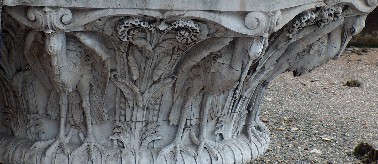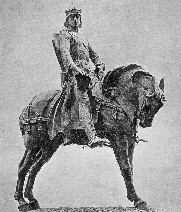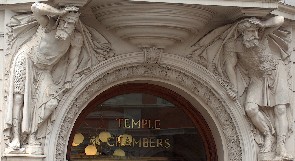 One of the pier sculptures under Blackfriars Bridge.
One of the pier sculptures under Blackfriars Bridge.
Blackfriars Bridge is not an unlikely passage across the river for us 21st Century Victorians, perhaps on the way from the Tate Modern to the Whitehall area, and is close to two of the walks on these pages; so it deserves a page of its own. It is itself a Victorian bridge, with modest sculpture by J. B. Philip. It gives us a poor view down river, and a good one up river. Nearby on the North shore is some decent sculpture, and the Bridge itself nearly had some rather splendid statues of its own, as we shall see.
The Victorian bridge replaced an earlier structure dating from the 1760s, originally intended to be named after William Pitt, but the name never stuck. The former bridge was built by a Scottish engineer called Robert Mylne, at a frugal cost of just over £150,000, a little less than the original estimate. It was 995 ft long and had nine elliptical arches. An early guide book notes the beautiful ionic pillars on each pier, and stairs down to the water at each end. Alas, the piers were 'of bad Portland Stone', and were never satisfactory, and costs of repairs, surpassing £100,000 by 1843, proved too much. The bridge was pulled down in 1864.
Today's bridge, then, is a Victorian one, by the illustrious builder and architect Thomas Cubitt, and dates from 1869. It cost £265,000, the cost being in part defrayed by a toll on those who crossed in the early years, just as for the first bridge a century before. A contemporary guide describes it as it appears today:
'This new bridge, of five beautiful segmental (not elliptical) arches, like the embankment which terminates at its north-western abutment, is one of the great metropolitan works of our era. It is of iron, with piers of granite. The architectural style is Gothic; and the style has been effectively applied under novel and somewhat difficult conditions. The piers are faced each one with a polished red granite shaft of massive proportions, having a richly-sculptured capital of Portland stone, upon which rests a kind of abacus, surrounded by sunk quatrefoil panels; these abaci really are open towards the road-way, and form projections from it, the parapets joining them and running from one to the other. The foliage, birds, fruit, &c., in these capitals and at the head of the massive abutments at either river-side, are sculptured with the utmost freedom and boldness; they are the work of Mr Philip. The iron-work is simple to severity, but the effect is fine, being at once solid and light, evidently strong while inherently elegant. Some lofty crowning accessories, such as lamps, are required to the great granite pier-columns, to give them a completely satisfactory effect.'
Others were more critical. From a journal just a couple of years later:
'With Blackfriars Bridge, we find the public thoroughly well pleased, though the design is really a wonder of depravity. Polished granite columns of amazing thickness, with carved capitals of stupendous weight, all made to give shop-room for an apple-woman, or a convenient platform for a suicide. The parapet is a fiddle-faddle of pretty cast-iron arcading, out of scale with the columns, incongruous with the capitals, and quite unsuited for a work that should be simply grand in its usefulness; and at each corner of the bridge is a huge block of masonry, apropos of nothing, a well-known evidence of desperate imbecility.'
In 1869, 'The close proximity of this very fine new bridge to the massive railway-bridge of the Chatham and Dover Railway will prevent its being seen to any advantage on the eastern side.' Today, the down stream side still has the view largely blocked, by a more modern railway bridge. But we can see the piers of the original rail bridge standing in the water, massive piles with simple swirly décor, and at the South Side, a big stone plinth with lofty ironwork declaiming 'London Chatham and Dover Railway, 1864.'
Earlier guides from before the rail bridge commended 'the fine view of St Paul's Cathedral... as well as of both sides of the river, including the Tower, the Monument, Somerset House, Westminster Abbey (these two looking the other way), and about 30 churches'. We can at least still see on the north side, the dome of St Paul's, and from the centre of the bridge, the golden top of the Monument. To the right of the latter, at the same height, is the yellow brick flanking wall and pair of towers with Moorish domes, which is Cannon Street Station (built 1865-6 for the S-E Railway, by J. Hawkshaw and J. W. Barry), with another railway bridge. Notable modern buildings are the former Nat West tower, and Norman Foster's Gherkin, and in the distance, Canary Wharf. Crossing the river, far away, is Tower Bridge.
Looking over the edge of the bridge, the piers with their Portland Stone sculpture can be seen - waterbirds of duck or goose nature on this side. Some have evidence of colouring on the bills; unusual in British outdoor animal sculpture. The sculptor is J. Bernie Philip.
 One of the pier sculptures under Blackfriars Bridge.
One of the pier sculptures under Blackfriars Bridge.
The bridge can be crossed at the southern side, at some traffic lights. On the upstream side, the sculpture on the capitals of the bridge Piers is better - swans, herons, some sort of bird of prey and a thick billed bird which might be a gannet (a guess, I am no ornithologist). The view of the north bank and looking upstream contains good buildings. Starting from the bridge, first is the much-pillared curve of the Unilever Building, dating from 1930/31, with rusticated ground floor, and at each end (only one seen from here) a massive stone group of a man restraining a horse - very typical work of the period. The work of the sculptor William Reid Dick. Alas, the free-standing pots and feminine figures higher up have been removed. Next to the Unilever Building is the former City of London School, dating from the 1880s, with four standing figures clearly visible. Next along, the red brick thoroughly ecclesiastical Sion College, by the architect Arthur Blomfield, 1886. Rather further off, by the next bridge (Waterloo Bridge), is William Chambers' Somerset House, with its Greek porticos and green dome, and further on the white steeple with pillars at the top of Waterhouse's National Liberal Club (1885-7) and adjoining Whitehall Court, 1884. Among church spires behind the river frontage can be seen the tower of St Brides, and further along, two more which mark the line of Fleet St and the Strand. On the south side of the river, only the 20th Century OXO building is of note.
The sad part of the story of Blackfriars Bridge is that of the equestrian statues that were to be on it. A competition was reported in 1881:
'Blackfriars Bridge is about to be adorned by statues to be placed on the four pedestals which have long awaited their crowning and completion. The statues are to be the subject of a public competition, the designs -either by drawings or models - to be sent to the Architect's Office, Guildhall, on or before the 21st of March next. Premiums of £250, £150, and £100 will be given for the models.'
The four winners were- Thornycroft for his Edward 1; C. B. Birch for his Henry V; Belt's William the Conqueror; and Edward III by Brock. But despite being invited to submit models and reports, five years on, the scheme was abandoned:
'It is finally announced that the project for crowning the pedestals of Blackfriars Bridge with sculpture representing passages in the history of London is to be abandoned. The arrangements for the proper conduct of this business have been shameful throughout, and Messrs Boehm, Thornycroft, Armstead and Birch [note the different list of sculptors] are not likely again to respond to a civic invitation to submit models and reports, unless approached and treated very differently. The corporation have done well to abandon the project, which was estimated to cost some £30,000, but they will do very badly if they suffer the sculptors who have spent their time in preparing designs and models to go unrewarded.'
 Hamo Thornycroft design for Blackfriars Bridge.
Hamo Thornycroft design for Blackfriars Bridge.
A short perambulation may be made from the north end of the bridge to see some sculpture. In the centre of the road, unreachable, at the northern end, is a Queen Victoria, by C. B. Birch, dating from 1893, some consolation for the lack of his Henry V ahorse referred to above.
On the eastern side of the road, a little towards one of the many entrances to Blackfriars station, is an excellent fountain, surmounted by a charming small statue of a graceful, lightly draped girl pouring from a pitcher. It is the work of Wills Bros. sculpt, working for the famous Coalbrookdale Iron Company. The girl is Temperance, and this fountain was presented in 1861 by no less than Samuel Gurney, founder of what later became the Metropolitan Drinking Fountain Cattle and Trough Association. It originally stood by the Royal Exchange, and was brought here in 1911.
At the beginning of Queen Victoria Street, to the right, is the Black Friar Pub, with a statue of a fat friar, the odd mosaic and panels of jumbled figures. Inside, bronze low reliefs are by Henry Poole, and date from 1906.
Crossing under New Bridge Street, go via the underpass to emerge by the Unilever Building. The larger figures have already been mentioned; in addition, the smallish entrances on the two flanks have low relief sculptural work - a nude mermaid on the river side, a merman on the corner of New Bridge Street. We can follow round the rear of Unilever to find a further entrance, with a large golden girl with starburst. Continuing leads through to Tudor St, parallel to the river. A left turn, a little along is John Carpenter Street, named after the founder of the City of London School we saw from the Bridge. On that street is the former Guild School of Music, a decorated palazzo stone building with commemorative panels to Tallis, Gibbons, Purcess, Arne, and Sterndale-Bennet, and musical and floral décor, This is an extension by the architect Andrew Murray (1897) to the original building dating from 1885-7 by Horace Jones, which faces on Tallis Street.
Alas, I don't know who did the sculptural work. Following Tallis Street, at the end are another pair of anonymous statues, two very serious and bulky warrior kings in stone on the front of Temple Chambers (1894). (See this page for more caryatid and atlantes figures, i.e. figures in place of supporting columns.) And turning towards the river, nos. 2-4 Temple Avenue has a seated pair of semidraped girls on a frieze above the principal entrance, and to either side, seven pairs of reclining cherubs in the round, above the windows.
Warrior kings at Temple Chambers.
Looping back towards Blackfriars Bridge along the Embankment passes Sion Hall, and then an opportunity to examine the City of London School statuary close up. On the side is Sir Thomas More, and four seated girls representing Elocution, Law, History and Literature, with appropriate accoutrements. And on the front, with several more allegorical girls, stand Francis Bacon, John Milton, Isaac Newton and William Shakespeare. What better choice to inspire the young scholars. The statues are by the obscure J. Daymond & Son and date from 1882; the building is by Davis and Emanuel. The building is described in more detail on the bottom of the Victoria Embankment page.
So ends the perambulation. For orientation or continuation, New Bridge St leads quickly through to Ludgate Circus, intersecting the end of Fleet Street to the left, and St Pauls to the right along Ludgate St. Straight across the Circus and on along Farringdon Road goes to Holborn Viaduct. Alternatively, sticking by the River and walking west towards Parliament follows the Victoria Embankment walk, with several good statues.
Eastwards to St Benet's Paul's Wharf // Further Eastwards to St James Garlickhythe // North to St Martins Ludgate
Visits to this page from 23 Nov 2011: 10,743